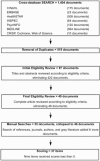Review of computer-generated outpatient health behavior interventions: clinical encounters "in absentia"
- PMID: 11141513
- PMCID: PMC134592
- DOI: 10.1136/jamia.2001.0080062
Review of computer-generated outpatient health behavior interventions: clinical encounters "in absentia"
Abstract
Objective: To evaluate evidence of the effectiveness of computer-generated health behavior interventions-clinical encounters "in absentia"-as extensions of face-to-face patient care in an ambulatory setting.
Data sources: Systematic electronic database and manual searches of multiple sources (1996-1999) plus search for gray literature were conducted to identify clinical trials using computer-generated health behavior interventions to motivate individuals to adopt treatment regimens, focusing on patient-interactive interventions and use of health behavior models.
Study selection: Eligibility criteria included randomized controlled studies with some evidence of instrument reliability and validity; use of at least one patient-interactive targeted or tailored feedback, reminder, or educational intervention intended to influence or improve a stated health behavior; and an association between one intervention variable and a health behavior.
Data extraction: Studies were described by delivery device (print, automated telephone, computer, and mobile communication) and intervention type (personalized, targeted, and tailored). We employed qualitative methods to analyze the retrieval set and explore the issue of patient interactive computer-generated behavioral intervention systems.
Data synthesis: Studies varied widely in methodology, quality, subject number, and characteristics, measurement of effects and health behavior focus. Of 37 eligible trials, 34 (91.9 percent) reported either statistically significant or improved outcomes. Fourteen studies used targeted interventions; 23 used tailored. Of the 14 targeted intervention studies, 13 (92.9 percent) reported improved outcomes. Of the 23 tailored intervention studies, 21 (91.3 percent) reported improved outcomes.
Conclusions: The literature indicates that computer-generated health behavior interventions are effective. While there is evidence that tailored interventions can more positively affect health behavior change than can targeted, personalized or generic interventions, there is little research comparing different tailoring protocols with one another. Only those studies using print and telephone devices reported a theoretic basis for their methodology. Future studies need to identify which models are best suited to which health behavior, whether certain delivery devices are more appropriate for different health behaviors, and how ambulatory care can benefit from patients' use of portable devices.
Figures
References
-
- Drake C. Consumers are using the Internet to revolutionize health care. AORN J. 1999;70:1068–9. - PubMed
-
- Gold WR. Facilitating the adoption of new technology for health promotion in health care organizations. In: Street RL, Gold WR, Manning T (eds). Health Promotion and Interactive Technology. Mahwah, NJ: Lawrence Erlbaum, 1997:209–20.
-
- Glanz K, Lewis FM, Rimer BK (eds). Health Behavior and Health Education: Theory, Research, and Practice. 2nd ed. San Francisco, Calif: Jossey-Bass, 1997.
-
- Rhodes F, Fishbein M, Reis J. Using behavioral theory in computer-based health promotion and appraisal. Health Educ Behav. 1997;24:20–34. - PubMed
Publication types
MeSH terms
LinkOut - more resources
Full Text Sources
Other Literature Sources



